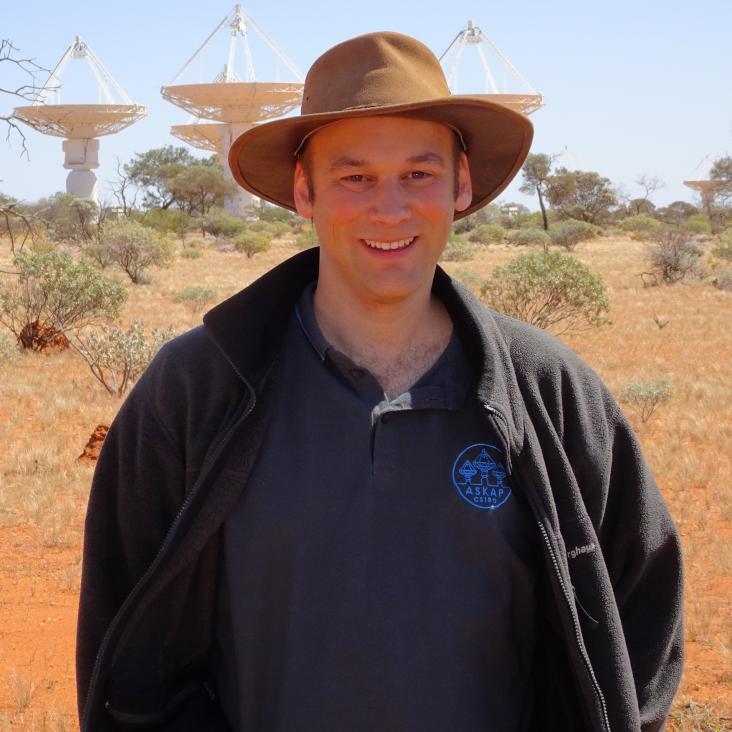Illuminating gravitational waves: A concordant picture of photons from a neutron star merger
Science American Association for the Advancement of Science 358:6370 (2017) 1559-1565
Abstract:
Merging neutron stars offer an excellent laboratory for simultaneously studying strong-field gravity and matter in extreme environments. We establish the physical association of an electromagnetic counterpart (EM170817) with gravitational waves (GW170817) detected from merging neutron stars. By synthesizing a panchromatic data set, we demonstrate that merging neutron stars are a long-sought production site forging heavy elements by r-process nucleosynthesis. The weak gamma rays seen in EM170817 are dissimilar to classical short gamma-ray bursts with ultrarelativistic jets. Instead, we suggest that breakout of a wide-angle, mildly relativistic cocoon engulfing the jet explains the low-luminosity gamma rays, the high-luminosity ultraviolet-optical-infrared, and the delayed radio and x-ray emission. We posit that all neutron star mergers may lead to a wide-angle cocoon breakout, sometimes accompanied by a successful jet and sometimes by a choked jet.Follow up of GW170817 and its electromagnetic counterpart by Australian-led observing programmes
Publications of the Astronomical Society of Australia Cambridge University Press 34 (2017) e069
Abstract:
The discovery of the first electromagnetic counterpart to a gravitational wave signal has generated follow-up observations by over 50 facilities world-wide, ushering in the new era of multi-messenger astronomy. In this paper, we present follow-up observations of the gravitational wave event GW170817 and its electromagnetic counterpart SSS17a/DLT17ck (IAU label AT2017gfo) by 14 Australian telescopes and partner observatories as part of Australian-based and Australian-led research programs. We report early- to late-time multi-wavelength observations, including optical imaging and spectroscopy, mid-infrared imaging, radio imaging, and searches for fast radio bursts. Our optical spectra reveal that the transient source emission cooled from approximately 6 400 K to 2 100 K over a 7-d period and produced no significant optical emission lines. The spectral profiles, cooling rate, and photometric light curves are consistent with the expected outburst and subsequent processes of a binary neutron star merger. Star formation in the host galaxy probably ceased at least a Gyr ago, although there is evidence for a galaxy merger. Binary pulsars with short (100 Myr) decay times are therefore unlikely progenitors, but pulsars like PSR B1534+12 with its 2.7 Gyr coalescence time could produce such a merger. The displacement (~2.2 kpc) of the binary star system from the centre of the main galaxy is not unusual for stars in the host galaxy or stars originating in the merging galaxy, and therefore any constraints on the kick velocity imparted to the progenitor are poor.Multi-messenger observations of a binary neutron star merger
Astrophysical Journal Letters Institute of Physics 848:2 (2017) L12
Abstract:
On 2017 August 17 a binary neutron star coalescence candidate (later designated GW170817) with merger time 12:41:04 UTC was observed through gravitational waves by the Advanced LIGO and Advanced Virgo detectors. The Fermi Gamma-ray Burst Monitor independently detected a gamma-ray burst (GRB 170817A) with a time delay of ∼1.7s with respect to the merger time. From the gravitational-wave signal, the source was initially localized to a sky region of 31 deg(2) at a luminosity distance of 40+8−8 Mpc and with component masses consistent with neutron stars. The component masses were later measured to be in the range 0.86 to 2.26 M⊙. An extensive observing campaign was launched across the electromagnetic spectrum leading to the discovery of a bright optical transient (SSS17a, now with the IAU identification of AT 2017gfo) in NGC 4993 (at ∼40Mpc) less than 11 hours after the merger by the One-Meter, Two Hemisphere (1M2H) team using the 1 m Swope Telescope. The optical transient was independently detected by multiple teams within an hour. Subsequent observations targeted the object and its environment. Early ultraviolet observations revealed a blue transient that faded within 48 hours. Optical and infrared observations showed a redward evolution over ∼10 days. Following early non-detections, X-ray and radio emission were discovered at the transient’s position ∼9 and ∼16 days, respectively, after the merger. Both the X-ray and radio emission likely arise from a physical process that is distinct from the one that generates the UV/optical/near-infrared emission. No ultra-high-energy gamma-rays and no neutrino candidates consistent with the source were found in follow-up searches. These observations support the hypothesis that GW170817 was produced by the merger of two neutron stars in NGC 4993 followed by a short gamma-ray burst (GRB 170817A) and a kilonova/macronova powered by the radioactive decay of r-process nuclei synthesized in the ejecta.Further observational evidence for a critical ionizing luminosity in active galaxies
Monthly Notices of the Royal Astronomical Society Oxford University Press (OUP) 470:4 (2017) 4600-4607
Connecting X-ray absorption and 21 cm neutral hydrogen absorption in obscured radio AGN
Monthly Notices of the Royal Astronomical Society Oxford University Press 471:3 (2017) 2952-2973


